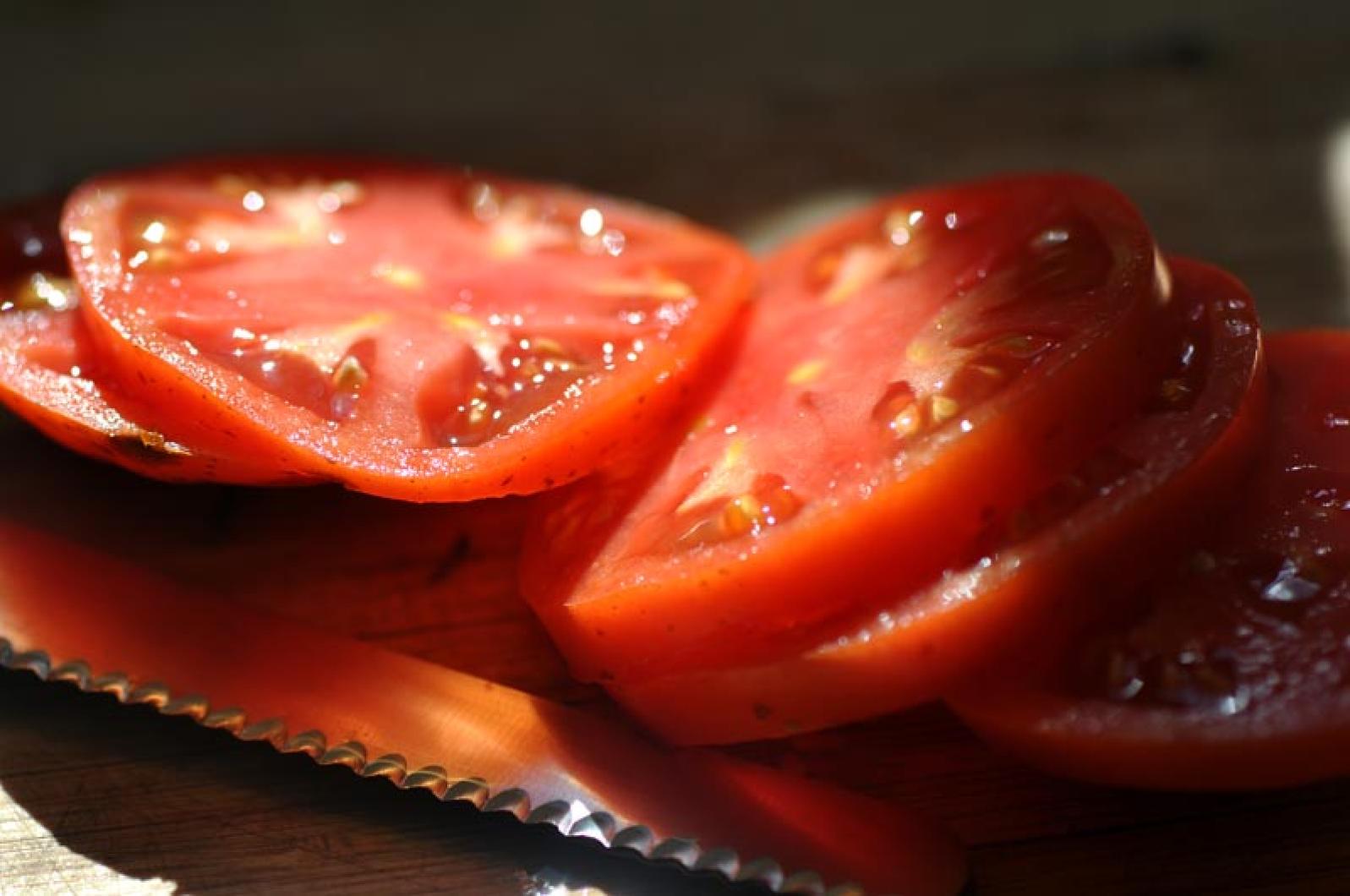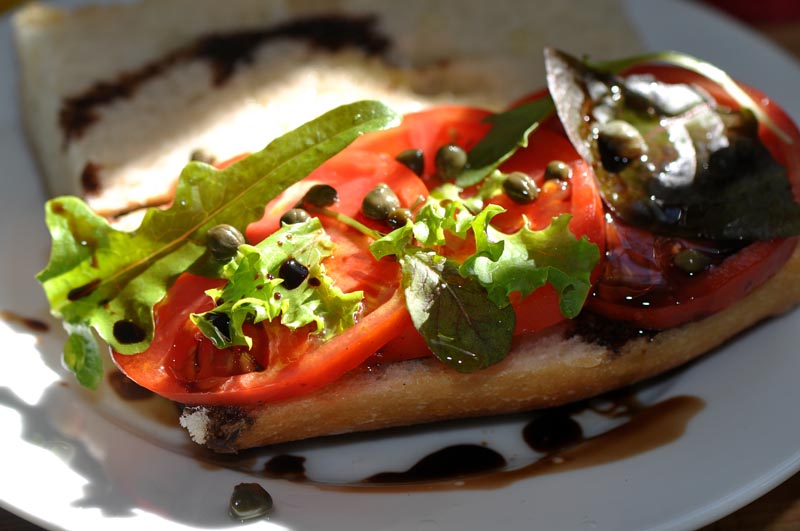My dad grows the best tomatoes. He drops them off for me in fruit boxes with padding in the bottom, treating them like soft-bottomed aristocrats riding into the farm on a horse-drawn chariot. The tomatoes do not touch one another and sit with their shoulders proud. The round ridge on the top of the tomato surrounding the base of its stem is known as the shoulder and is Mario Batali’s favorite part (they look like shoulders when examined closely; after having that image planted in your head, try it). Not all the tomatoes he brings me look perfect. Some are noticeably blemished, but all are brilliantly red and ripened to perfection on the vine of his plants before being plucked off with a sharp pair of pruning shears. It takes patience and discipline to wait for that day.
He drops them off without much of a show. This morning he left them for me on our harvesting station before I had even arrived at work. We cut one up right away and ate it with our eggs. The juice of the tomato coated every bite adding a completeness to each bite with its rich, tart body of flavor. He doesn’t usually ask what I do with them, knowing they have been the foundation for simple traditional dishes while also inspiring me to figure out the best possible way to honor what he has grown so well. It makes me feel like a young child to be cared for so well by him into my adulthood. He never taught me about money and I have had to learn a lot of lessons the hard way, but I watched him grow tomatoes.
He treats his tomatoes with respect. He believes in them and cares for them with a sensitivity to their needs learned over a lifetime. He collected huge buoys for years on the beach, cutting off their rust-resistant poles at what seemed to me when I was young, to be at least 20 feet in length. He grew giants. When I was just learning to walk I could wander beneath his plants with tomatoes above me the size of softballs casting shadows all around me. I couldn’t reach most of them, but as I got older I could pick ones from the lower branches and eat them like apples with the heat of the sun still inside them and their juices running down my chin. He grew tomato plants that looked like oak trees in the town of Aquinnah where the legend of Moshup tells the story of a giant, beautiful man living off the land and staining the cliffs with the blood of whales.
To pound the stakes into the ground he brings out an eight-foot step ladder and pounds them in well above what he could reach from the ground. He lines up his rows and puts all his stakes in before the soil is warm enough for the plants to go into the ground. His soil has been super-charged with thick mounds of his compost and the winter rye has been tilled in. He is telling his plants he believes in them and gives them everything they need to reach great heights. They want to grow for him and make him proud. As they grow lankier and taller, he prunes them into a single strong stalk and supports every plant periodically as they make their way around their pole. His method looks sparse at first, and I still haven’t learned that by giving your plants more space they will grow stronger and fuller and will produce more throughout their life. Year after year I continue to plant my tomatoes too close together.
Our plants on the farm this year are in long straight rows about four feet apart; they have long outgrown their trellising and have begun to form canopies above each walking aisle. To pick tomatoes means to crawl on your hands and knees down each pathway on the biodegradable black mat we used to line the beds. I joked last Saturday morning that one of the pickers that morning might never emerge from the abyss of tomato greenery. Once engulfed in the tomato plants the sun is completely blocked and a headlamp would actually prove to be useful when picking. I felt like I was crawling deeper and deeper into a cave and that I might come upon a new little village of gnomes on their lunch break, sitting around a fire eating tomatoes. Chickens hunt and peck at eye level all around the plants looking for hornworms and drinking from puddles. When a scavenging chicken finds a hornworm, it is like a starving person finding a whole Thanksgiving turkey roasted and perfectly cooked, all for themselves. This is how I feel when eating one of my dad’s tomatoes.
Biting his tomato is like capturing energy from the sun bit by bit. I usually eat them still warm with salt; it is all they need. His tomatoes are juicier than any I know and if you cut into one it should be on the plate you plan to serve them on because you do not want to lose an ounce of this gift. The juice is viscous and falls somewhere between olive oil and honey. Salt brings out the layers of acidic sweetness that reflect the characteristics of his growing environment. Seaweed is used heavily in his compost, mine as well, and this provides millions of unnamed nutrients to the spectrum of minerals needed to grow tomatoes like his. I don’t think tomatoes taste anything like seaweed, but the sodium from the seaweed helps to salt the tomato from the inside showing off the complexity and the depth of flavor. If you want a simple pleasure, then eat a tomato with just salt. If you want to know what it is like to ride into your castle on a horse-drawn chariot, then try a sliced tomato covered in mayonnaise and generously salted. My dad taught me that.
Recipe for mayonnaise
1 egg yolk
4 tablespoons canola oil
1 teaspoon water
1 teaspoon lemon juice
pinch of salt
Place an egg yolk in the center of a mixing bowl. Whisk the salt into the egg yolk. Very slowly drizzle the canola oil over the egg yolk while whisking vigorously to form an emulsion. Continue to whisk until you have formed a thick emulsification, thin with water as needed and add lemon juice to finish.
Pairs well with fresh tomatoes.
3 cloves of garlic, peeled and cut into slivers
3 pounds of ripe fresh tomatoes
2 tablespoons olive oil
2 medium-sized eggplant, cut into ½ inch cubes
3 cups loosely packed whole basil leaves
1 cup grated ricotta salata
1 pound rigatoni
Boil a large pot of salted water for the pasta. When the water comes to a boil, plunge the tomatoes into the water for one minute. Remove them with a slotted spoon and slip the skins off. Take two separate saute pans and add one tablespoon of olive oil to each over high heat. Toast the garlic in one and heat the oil in the other, very hot, then add the diced eggplant. Add the cleaned tomatoes to the garlic pan once they have just begun to gain color. Meanwhile, brown the eggplant in batches as needed to cook them through and give them a deep brown color. Remove the eggplant to a baking sheet lined with paper towels while cooking the tomato sauce down for at least an hour and a half. When the tomato sauce is thick and cohesive, add the eggplant and basil. Salt conservatively, knowing the cheese will add more, and stir to incorporate. Drop the rigatoni into the boiling water and cook until it still has the slightest bite to it, then drain and add to the tomato sauce, tossing with the ricotta salata, and serve immediately.








Comments
Comment policy »